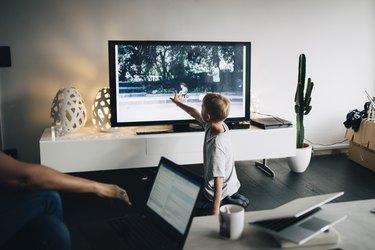
Though some people might dub them "hot spots," the blemishes and glowing blobs that appear on your brand-new 4K smart TV's screen are not nearly as fun as a hip new nightlife locale. No matter whether you call them spots, clouds or discolorations – or if you call them just plain annoying – these LCD flaws occur for a variety of different reasons, which call for an equal variety of solutions. So put down that remote and get to solving in time for your Netflix binge.
Banish Backlight Bleed
Video of the Day
If you've got something on your flat panel LCD that looks like a "hot spot" – a faintly glowing, white emission from the edge of the screen – there's a good chance you're dealing with backlight bleed. Also known as flashlighting or clouding, this occurs when there's too much pressure between the panel or frame and the backlight that illuminates the display, creating a warping effect.
Video of the Day
The solution is to get rid of that pressure. Turn off and unplug your TV and cover your work space – in this case, the floor or a large, flat table – with a clean, soft towel or blanket. Lie the TV face-down on the work surface and very slightly loosen the screws on the back of the panel with a screwdriver. A half-turn counterclockwise is all you need here, and no more.
If the spots persist, rub the areas where they occur in a circular motion with a clean microfiber cloth, applying just enough pressure to warp the screen's reflection only slightly. For extra insurance, leave the TV off for a day to allow the screen to settle before powering it back on again.
Clean Away an LCD Spot
When you've got a yellow spot on your TV screen or a blemish that looks vaguely blotchy or cloudy, it's possible your LCD just needs a good cleaning.
For best results, turn the TV off so that it displays a blank screen – that way, you can see the surface you're cleaning. Use a clean, dry and non-abrasive 100-percent cotton cloth, avoiding any sort of liquids, chemicals or cleaners, which may worsen the issue or even damage your screen. Firmly wipe the whole surface of the LCD with upward strokes, then flip your cloth and move fully across the entire screen in long, horizontal motions.
You might just be surprised at the picture-blurring dust and grime that's collected on your TV over the years. Once you're done cleaning, turn the TV back on and enjoy the newfound clarity.
Dealing with Dead Pixels
Got small, bright green pixels on your TV screen? What about red pixels in dark areas on the TV? Or a tiny, distracting white dot? Bright, lively and distracting as these little specks may be, these bugbears are commonly known as dead pixels.
Because LCD and OLED screens are typically composed of more than two million dots known as pixels, dead pixels – pixels that don't change color – are extremely common. Luckily, they're usually only noticeable when displaying a solid color on screen.
Sometimes, a good wipe-down solves the issues, as it's easy to mistake a speck of lint or debris for a dead pixel. If the pixel persists, we've got some good news: Dead pixels often correct themselves over time. Otherwise, replacing your LCD TV is your only option for fixing these dots, but be wary – dead pixels are so common that the TV makers at Sony say that there's "a high probability" the replacement would suffer from the same issue, or "potentially have an even greater number of defective pixels." Sometimes, the pursuit of absolute perfection just isn't worth it.